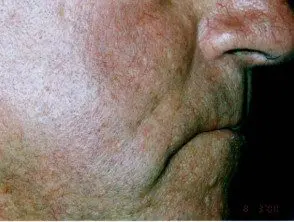Copper bromide To be The system is output as yellow and / or green light, typically as short 10-50 millisecond pulses of up to 2 watts.
Yellow light is used very effectively to treat vascular lesions (red)
- Facial telangiectasia
-
Spider telangiectasia, Cherry angiomas and venous lakes
- Small port wine stains (vascular malformations).
The small size of the stain makes it impractical to treat large port wine stains effectively. Laser treatment is much more effective and better tolerated than diathermy or electrolysis.
Facial telangiectasia before and after copper bromide laser treatment.

Telangiectasia

Telangiectasia
Green light is used to treat pigmented lesions (brown)
- Lentigos
- Freckles
- Benign moles
It is important that the diagnosis is clear: the copper bromide laser should not be used to treat melanoma.
Yellow and green combined light is sometimes used to treat superficial skin-colored lesions as an alternative to cryotherapy (frostbite) or surgery.
- Seborrheic keratosis
- Actinic keratoses
- Skin tags
- Skin disease papulosa nigra
- Trichoepitheliomas
- Adenoma sebaceous
- Warts
-
Benign moles.
To eliminate the danger of laser light burning the back of the eye (the retina), the patient's eyes are covered with steel or lead eye protectors. The laser operator must wear special goggles that allow reasonable vision while protecting their vision from injury. The glasses are also available for another person to observe the treatment.
The patient lies in a comfortable chair or armchair. Local or general anesthetic It is generally not necessary for copper bromide laser treatment, which is generally well tolerated by adults and older children. It feels like a brief burning or stinging sensation.
Vascular lesions treated whiten briefly when exposed to yellow light. A single session rarely exceeds 40 minutes, depending on the extent of the skin problem. The treated skin appears quite red for a few hours. The next day there may be located swelling and crust Eyelid swelling is occasionally quite severe, but rarely lasts for more than a few days.
Green light causes the surface of pigmented lesions to turn gray and then form a dark crust. After a couple of weeks, the skin peels off leaving a pale injury. The combined light acts as an electrocautery and destroys easily scraped lesions.
For best results, most patients require two to four treatments, usually at intervals of at least six weeks.

